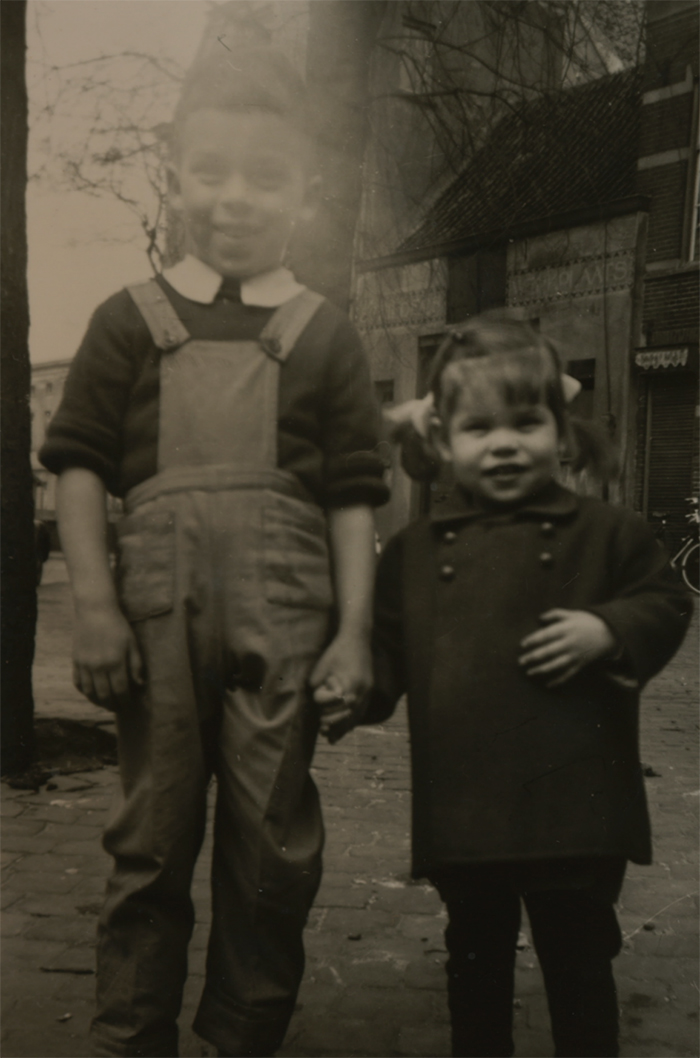LILY VAN DER STOKKER
The cutest little picture of me and my youngest brother Martin at the triangle square called in Dutch Sint Janskerkhof (Saint John’s Graveyard). This is where I grew up until I was six years old, in the shadow of the St. John’s Cathedral (de Sint Jan) in ‘s-Hertogenbosch, in the south of The Netherlands. We lived and played in a large merchant’s house built around the 1400 hundreds. Not that I was aware of it, but to me as a kid this house was like a castle, the many rooms and secret stairs leading to other secret attics full of things to discover. In the picture I am wearing the blue coat my mother made for me. She made all my clothes. My eyes being blue, it is still my favorite color. A few years ago, I went back to the house. My parents had a furniture store there when I grew up. My brother Ad had continued the furniture business from my parents. This was on the ground floor from the streetside to the backyard. He kept the old house above for furniture storage, but many of the rooms had been unused for a long time and the house was neglected and in a bad shape. Ceilings were coming down. The roof had to be repaired and my brother wanted to fix it up for one of his kids to be a modern apartment with a decent bathroom, kitchen etcetera.
Then one day Ad brought to my attention that some historical building researchers had took advantage of these months where the house was unused, to do their work, because the researchers knew that some of the rooms had been untouched by renovations since 60-70 years. Under the plaster they discovered old wood structures that proved that some of the rooms in the house were from around 1470. In some areas, where plaster layers had not been damaged by previous renovations, old wall paintings slowly appeared which the researchers had exposed. In the narrow steep stairs leading to my parents’ bedroom where I was born in the fifties, fragments of texts were appearing. We could decipher them to be black Gothic lettering reading AVE MARIA, with beautiful realistic painted red drapery above the text. Just imagine what this house must have looked like. In this overlooked much too steep, narrow and unpractical stairway, and what we called as kids the blue room, a large room in which me and my brothers played with our “Lego” blocks and build kids stuff and crawled over the blue vinyl floor, proved to be the oldest room in the house. Beautiful red lily decorations in a regular pattern with below a paneling from the ground up of fake painted wood appeared from under the layers of paint. In another room they found ceiling paintings from the 18th century. This had been our living room when I was 1 to 6 years old. When I met the woman who was scraping the walls millimeter by millimeter with a tiny knife, I discovered her to be as devoted to her work as I am in my art. She told me it was her life’s work applying and waiting for subsidies to have the once in a lifetime opportunity to work on a residential house like this. Because these apparently didn’t come available that often for historians. And when she heard that after growing up in this house, I had become a wall paintings artist, she touched her heart, saying that playing as a kid in this blue room with these hidden wall paintings in it from various times, must have destined me to become a wall painting artist. And if you think of it, these paintings were made right in the time of Hieronymus Bosch’s life. In this neighborhood in this street, he must have made his visits and met people. For sure he visited across the street the house of the Swan Brothers Fraternity of which he was a member. We were fantasizing about how people would have behaved in this civilian house during those times. For a while I thought it must be my task to restore this house the way it once was. I fantasied about finishing the existing wall paintings into a completely decorated house with textiles and furniture’s. Like my own desire in my artwork at that moment to indulge in surrounding domestic and decorative patterns with colors and curls. But it was no more than a fantasy. It wasn’t my house anymore. It was good that it was going to be modernized for young people from today to live in.
The historian, Maike Tjon A Kauw, told me that usually churches and public buildings get restored but there is very little subsidy for restoring civilian houses from that time and keep them as they were. What remains now of the wall paintings of hundreds of years ago in Hinthamerstraat 119-121, ‘s-Hertogenbosch, the place of my birth, are small remainders of them here and there in the house which are kept in openings in the plaster behind glass.

—
Lily van der Stokker was born in Hertogenbosch, Netherlands, in 1954, she lives and works in Amsterdam and New York City. Selected solo exhibitions include: Camden Art Centre, London (2022); Migros Museum für Gegenwartskunst, Zurich (2019); Stedelijk Museum, Amsterdam (2018); Hammer Museum, Los Angeles (2015); New Museum, New York (2013); Museum Boijmans Van Beuningen, Rotterdam (2010); and Tate St. Ives (2010). Van der Stokker has undertaken two large-scale public commissions. In 2000 she created The Pink Building, for which she painted the entire exterior and roof of a building for the World’s Fair in Hannover, Germany, and she designed a large ceramic teapot, Celestial Teapot, for the roof of a high-rise shopping centre in Utrecht, Netherlands, in 2013.
